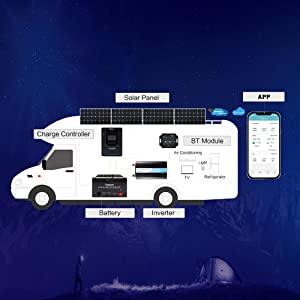Introduction To Solar Power
For a long time Solar Power was identified as the conversion of sun light to electricity. While this is not inaccurate, most of us don’t know that energy harvested from the sun must first be converted into electrical energy to produce functional electricity. This conversion is made possible through photovoltaic (PV) cells, mostly manufactured from Monocrystalline material. This method uses semiconductors to convert the sun’s radiation to electrical energy, which can then be routed to an inverter, with the use of an MPPT controller, and charging a bank of batteries.
Components of a Simple Solar Power System
Solar or photovoltaic monocrystalline cells
The assembly of semiconductors and electronics or solar cells is enclosed in a photovoltaic module, more commonly known as a solar panel, usually constructed from monocrystalline material. Several solar panels are called solar panel array.
Battery
A solar panel collects and generates energy from the sun’s radiation which is then sent from the solar panels to a bank of batteries. This energy can be used as direct current (DC) electricity, a current that is produced by batteries, or routed through an MPPT controller and then through an inverter to be used alternating current (AC).
Regulator or MPPT Controller
A regulator is optional but vital in keeping your battery bank from overcharging from the photovoltaic system. During the cyclic process, the battery is likely to become overcharged or over-discharge, a situation that shortens the batteries’ lifespan. A regulator prevents such situations from happening by regulating the batteries’ condition. It maintains a state of charge where it monitors when the battery will be overly charge or discharge. In general, a regulator keeps the batteries in the most appropriate working conditions.
Converter / Inverter
A converter allows the DC electricity stored into the batteries to be converted to AC or alternating current electricity, the type of energy that is used by appliances, such as refrigerators, computers, etc. The DC/AC or direct/alternating converter is also referred to as an inverter and is used to match the required current and voltage by the load. It is typical to experience some energy loss during electricity conversion.
One of my favorite systems on the market is one used by a lot of van-lifers and RV’ers who travel and live “off the grid” yet still need reliable power. In my personal opinion, Renogy Solar Products produces the best solar systems, and are easy enough to install for beginners.
Renogy Premium Kits
Renogy Premium Kits use the most efficient products to boost your off-grid system to its highest potential. Kits includes the Mono Solar Panels which are not only sleek in size, weight, and color, but are also made of the highest efficiency solar cells that Renogy has to offer.
The included Rover MPPT Charge Controller features multiphase synchronous rectification and Maximum Power Point Tracking technologies, which increase charging efficiency. Renogy’s new Bluetooth module is also included in their kits which can be paired to the DC Home APP. The DC Home APP allows users to remotely monitor and change their photovoltaic system’s parameters with a few simple swipes on their smartphone or tablet.
For convenience, Renogy’s solar kits also consist of two sets of mounting Z-Brackets, a 10AWG Solar Adaptor Kit, one 8ft 8AWG Tray Cable, and fusing components for your controller and battery.
This Premium Kit is perfect for installation on an RV, boat, or camper, or a “do-it-yourself” van lifer vehicle.
My rating on this kit is 4-1/2 out of 5 stars.

